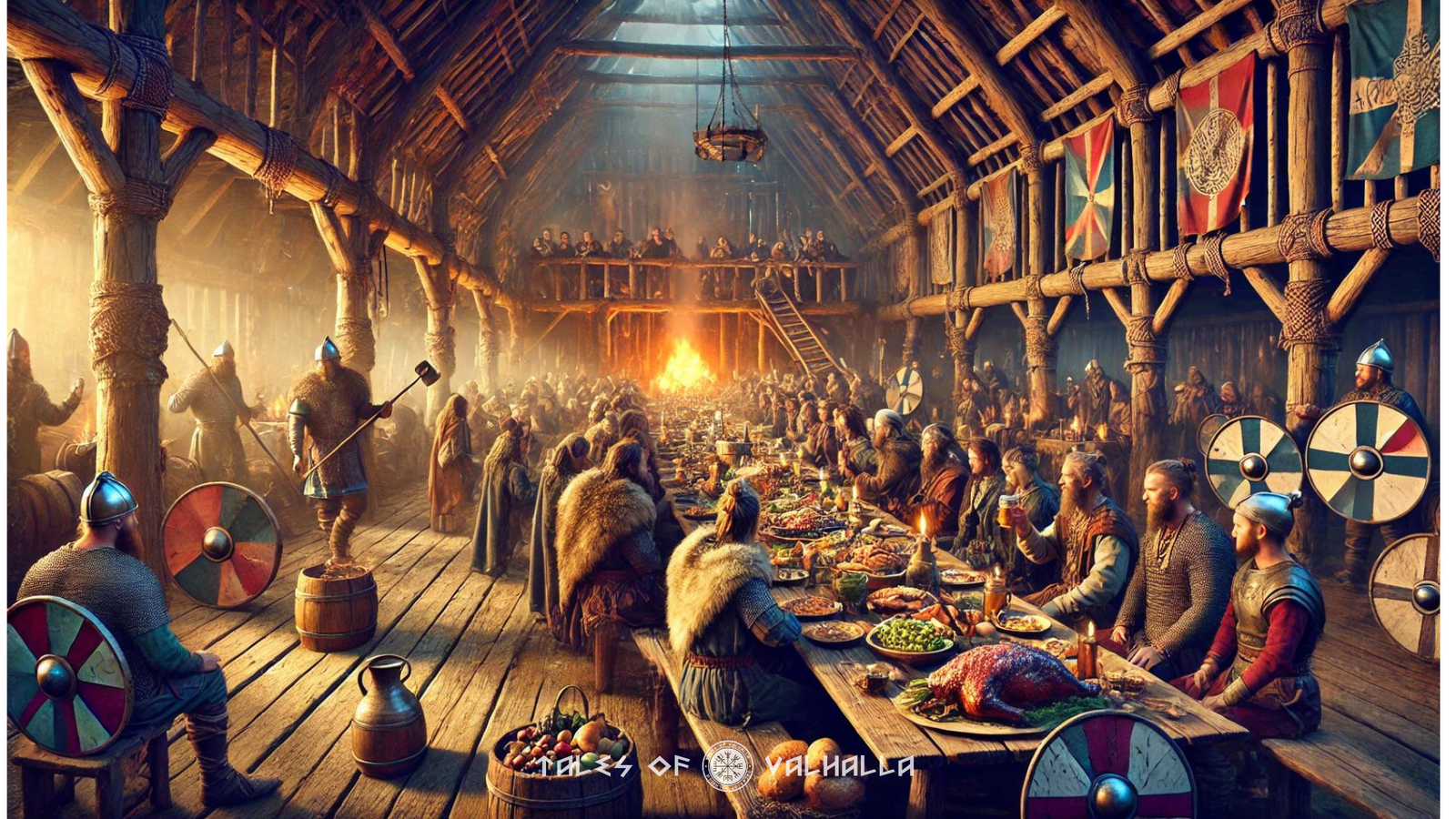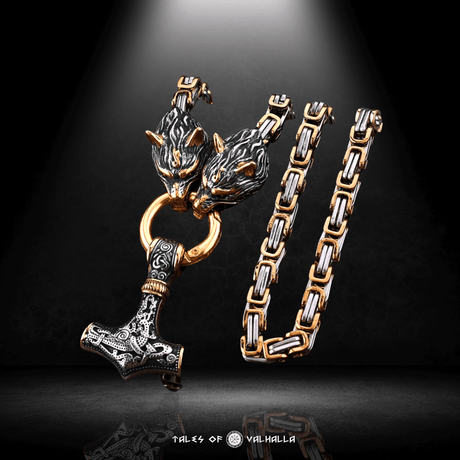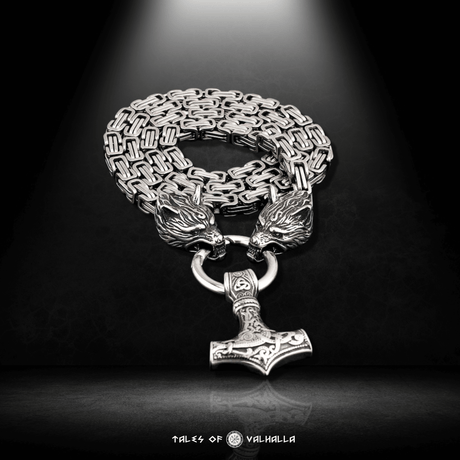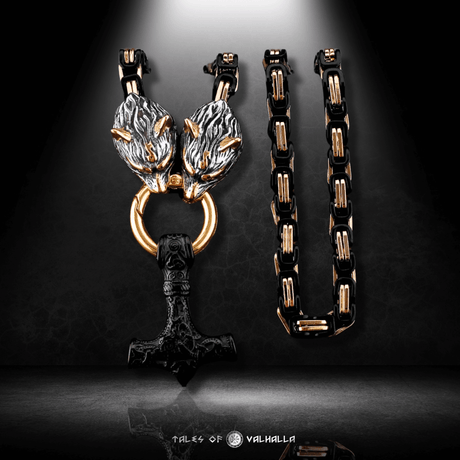The Viking Feast - A Glimpse Into the Past
Imagine a grand hall filled with the warm glow of firelight, where the sounds of laughter and storytelling echo off wooden walls adorned with shields and tapestries. Long tables are laden with hearty dishes—roasted meats, freshly baked bread, and bowls of steaming stew. Horns of mead are passed around as warriors and farmers alike celebrate the spoils of their latest endeavors. This is the Viking feast—a central element of Norse culture that went far beyond mere sustenance.
In the Viking world, food was not just about survival; it was a key component of social and religious life. Feasting was a communal event that brought people together, reinforced bonds, and honored the gods. Today, as interest in Viking culture and history continues to grow, there is a renewed fascination with the culinary traditions of this ancient people. Rediscovering and recreating Viking cuisine offers a unique way to connect with the past and experience the flavors that once fueled these legendary warriors.
The Relevance of Viking Cuisine Today
Why revisit the food of the Vikings? In an age where farm-to-table and organic movements emphasize the importance of natural ingredients and traditional methods, Viking cuisine offers a compelling example of how our ancestors thrived on simple, hearty meals that made the most of their environment. The techniques and flavors of Viking cooking provide a glimpse into a world where food was deeply intertwined with the land, the seasons, and the social fabric of the community. By exploring Viking culinary traditions, we can not only satisfy our curiosity about the past but also enrich our modern kitchens with time-tested recipes and methods.
The Staples of Viking Diet

The Staples of Viking Diet
Grains, Vegetables, and Legumes
The Viking diet was largely based on what could be grown or gathered from the land. Grains such as barley, rye, and oats were staples, forming the base of many meals. Barley was particularly important, used to make bread, porridge, and even beer. Rye, another essential grain, was often ground into flour for dark, dense bread that could last through the long Scandinavian winters. Oats, meanwhile, were commonly used in porridge, a versatile dish that could be sweetened with honey or mixed with savory ingredients like smoked meat.
Vegetables and legumes also played a crucial role in Viking meals. Root vegetables like carrots, parsnips, and turnips were commonly grown and could be stored for long periods. Cabbage, leeks, and onions were other important crops, adding flavor and nutrition to stews and soups. Peas and beans, which were easy to cultivate and rich in protein, were often cooked into thick pottages, providing sustenance during the colder months when fresh produce was scarce.
Meat, Fish, and Dairy
Meat was a significant part of the Viking diet, especially for those who could afford it. Livestock such as cattle, pigs, sheep, and goats provided a steady supply of meat, milk, and cheese. Pork, in particular, was highly prized, often salted or smoked for preservation. Lamb and mutton were also common, as sheep thrived in the Scandinavian landscape. Hunting supplemented the Viking diet with game such as deer, wild boar, and birds, while fishing provided a vital source of protein in the form of freshwater and saltwater fish.
Fish, especially herring and cod, were staples in the Viking diet. These were often dried, smoked, or salted to ensure they could be stored for long periods. In coastal regions, seafood such as mussels, oysters, and seaweed was also consumed. Dairy products, including milk, cheese, and butter, were essential for adding richness and calories to the diet, especially in winter.
Fruits, Nuts, and Honey
Although the harsh climate limited the variety of fruits available to the Vikings, they still enjoyed what nature provided. Wild berries such as bilberries, lingonberries, and cloudberries were gathered in the summer and preserved for use throughout the year. Apples, one of the few fruits that could be cultivated in the Scandinavian climate, were also popular. Nuts, particularly hazelnuts, were foraged from the wild and used in both cooking and baking.
Honey was the primary sweetener in Viking cuisine, valued not only for its sweetness but also for its role in brewing mead, the legendary Viking beverage. Honey was also used in cooking and as a preservative, helping to extend the shelf life of fruits and other perishables.
Viking Cooking Techniques

Viking Cooking Techniques
Open Fires and Hearth Cooking
The Vikings primarily cooked their food over open fires or in hearths, which were the central feature of any longhouse or hall. Cooking over an open flame required skill and attention, as controlling the heat was essential for preparing meals properly. Vikings used a variety of tools and utensils, including cauldrons hung over the fire, spits for roasting meat, and clay ovens for baking bread.
Boiling, roasting, and baking were the most common cooking methods. Meat was often boiled in large cauldrons to create hearty stews, while bread was baked in clay ovens or on flat stones placed in the fire. Roasting meat on a spit was reserved for special occasions, such as feasts or celebrations, where the sight and smell of the roasting meat added to the festive atmosphere.
Fermentation and Preservation
Given the long, harsh winters in Scandinavia, preserving food was crucial for survival. The Vikings employed various techniques to ensure their food supplies lasted through the cold months. Fermentation was a key method, used to preserve vegetables, dairy, and even fish. Fermented fish, known as "rakfisk," was a delicacy that could be stored for months.
Smoking was another common preservation technique, especially for meat and fish. By hanging these foods over a slow-burning fire, Vikings could extend their shelf life while adding a distinctive smoky flavor. Salting was also widely used, particularly for preserving meat and fish, as salt helped to draw out moisture and prevent spoilage. Pickling, using a mixture of salt and vinegar, was another way to preserve vegetables and fruits for later consumption.
The Viking Feast: Rituals and Social Significance

The Viking Feast: Rituals and Social Significance
Feasting as a Social and Religious Event
Feasting was a central part of Viking culture, serving as a time to celebrate victories, honor the gods, and strengthen social bonds. These events were more than just meals; they were significant social gatherings that reinforced the hierarchy and cohesion of Viking society. Leaders, warriors, and common folk alike would come together to share food, drink, and stories, creating a sense of community and shared identity.
The mead hall was the heart of Viking social life, where feasts took place. These halls were often large, communal buildings where people would gather around long tables, with the head of the household or the local chieftain presiding over the event. Food and drink were served in abundance, with meat, bread, and ale or mead being the main staples. Feasts often lasted for hours, with singing, storytelling, and even games adding to the merriment.
Food and Drink Offerings to the Gods
Feasting also had a strong religious dimension in Viking culture. Many feasts were held in honor of the gods, particularly Odin, Thor, and Freyja, who were believed to influence the harvest, warfare, and fertility. Food and drink offerings were made to these deities as a sign of respect and to ensure their favor. Sacrificial animals, often pigs or cattle, were sometimes slaughtered during these events, with the best portions of the meat offered to the gods before the rest was consumed by the attendees.
The importance of food in religious ceremonies is also evident in the Viking practice of "blót," a ritual sacrifice and feast held to honor the gods and spirits. During these ceremonies, participants would offer food and drink to the gods, often pouring ale or mead onto the ground as a libation. The remaining food and drink would then be shared among the community, reinforcing the bond between the living and the divine.
Recreating Viking Dishes: Recipes and Modern Interpretations

Recreating Viking Dishes: Recipes and Modern Interpretations
Simple Viking Recipes for the Modern Kitchen
For those interested in bringing a taste of Viking cuisine into their modern kitchens, here are a few simple recipes inspired by the Norse era:
-
Hearty Viking Stew: Combine diced lamb or pork with root vegetables like carrots, turnips, and onions in a large pot. Add barley, fresh herbs, and enough water to cover the ingredients. Simmer over low heat until the meat is tender and the flavors have melded together. Season with salt and pepper to taste.
-
Barley Bread: Mix barley flour with water, a pinch of salt, and a small amount of honey to create a dough. Knead the dough until smooth, then shape it into small rounds. Bake in a preheated oven at 375°F (190°C) for 20-25 minutes, or until the bread is golden brown.
-
Mead (Simple Recipe): Combine 2-3 cups of honey with 1 gallon of water in a large pot. Heat the mixture until the honey is fully dissolved, then allow it to cool. Add yeast and transfer the mixture to a fermentation vessel. Seal the vessel with an airlock and let it ferment for 4-6 weeks. Once fermentation is complete, bottle the mead and allow it to age for a few more weeks before enjoying.
Adapting Viking Flavors for Today’s Palate
While traditional Viking recipes are hearty and flavorful, they may not always suit modern tastes or dietary preferences. Here are a few tips for adapting these ancient dishes to contemporary kitchens:
Ingredient Substitutions: If barley flour is hard to find, you can substitute it with whole wheat flour in bread recipes. For a gluten-free option, consider using buckwheat or oat flour. Similarly, if lamb or pork is not to your liking, chicken or beef can be used in stews.
Modern Cooking Techniques: While cooking over an open fire adds authenticity, it’s not always practical. Instead, use a slow cooker or Dutch oven to replicate the slow, even cooking of Viking stews. For a smoky flavor, consider adding smoked salt or smoked paprika to your dishes.
Balancing Flavors: Viking cuisine often featured bold, earthy flavors. To balance these, try adding a touch of acidity with vinegar or citrus, or a hint of sweetness with honey or dried fruits. Fresh herbs like thyme, rosemary, and dill can also brighten up traditional Viking dishes.
The Legacy of Viking Cuisine
Influence on Scandinavian Cuisine
Viking culinary traditions have left a lasting impact on modern Scandinavian cuisine. Many of the ingredients and techniques used by the Vikings are still prevalent in Nordic cooking today. Dishes like rye bread, smoked fish, and pickled vegetables have their roots in the Viking era and continue to be enjoyed across Scandinavia.
The emphasis on simple, hearty ingredients that are locally sourced and seasonally appropriate is a key feature of both Viking and modern Nordic cuisine. This focus on sustainability and respect for the land has made Scandinavian cooking a model for the global culinary community.
The Enduring Appeal of Viking Feasts
The fascination with Viking culture has only grown over time, leading to a revival of interest in their culinary traditions. Viking reenactment events, complete with authentic feasts, have become popular around the world, allowing participants to experience the sights, sounds, and flavors of the Norse era. Themed restaurants and cookbooks dedicated to Viking cuisine also offer modern interpretations of ancient recipes, bringing these dishes to a wider audience.
For many, the appeal of Viking feasts lies in their communal nature and the connection they offer to a distant past. In an age where fast food and individual dining are the norms, the idea of gathering around a table with friends and family to share a meal prepared with care and tradition is both comforting and appealing.
Conclusion
Rediscovering Viking cuisine offers a unique opportunity to connect with the past and explore the flavors that sustained one of history’s most legendary cultures. By incorporating traditional Viking ingredients and cooking techniques into your modern kitchen, you can bring a taste of the Norse era to your table. Whether you’re hosting a Viking-themed feast or simply looking to try something new, these recipes and ideas provide a delicious way to honor the culinary excellence of the Vikings.






























































































